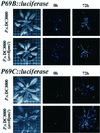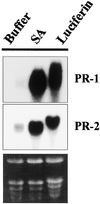Local and systemic induction of two defense-related subtilisin-like protease promoters in transgenic Arabidopsis plants. Luciferin induction of PR gene expression
- PMID: 11080282
- PMCID: PMC59204
- DOI: 10.1104/pp.124.3.1049
Local and systemic induction of two defense-related subtilisin-like protease promoters in transgenic Arabidopsis plants. Luciferin induction of PR gene expression
Abstract
Following a pathogenic attack, plants are able to mount a defense response with the coordinated activation of a battery of defense-related genes. In this study we have characterized the mode of expression of the P69B and P69C genes from tomato (Lycopersicon esculentum Mill.), which encodes two closely related subtilisin-like proteases associated with the defense response. We have compared the mode of gene regulation in heterologous transgenic Arabidopsis plants harboring promoter-beta-glucuronidase (GUS) and promoter-luciferase (LUC) gene fusions for these two genes. These studies revealed that the P69B and P69C promoters are induced by salicylic acid as well as during the course of both a compatible and an incompatible interaction with Pseudomonas syringae. Furthermore, P69B and P69C expression takes place in both the local and the distal (noninoculated) leaves upon inoculation with bacteria but following different and unique tissue-specific patterns of expression that are also different to that described for most other classical PR genes. Also, we report that luciferin, the substrate for the reporter luciferase (LUC) gene, is able to activate expression of PR genes, and this may pose a problem when using this gene reporter system in studies related to plant defense.
Figures







Similar articles
-
A GUS/luciferase fusion reporter for plant gene trapping and for assay of promoter activity with luciferin-dependent control of the reporter protein stability.Plant Cell Physiol. 2007 Aug;48(8):1121-31. doi: 10.1093/pcp/pcm081. Epub 2007 Jun 27. Plant Cell Physiol. 2007. PMID: 17597079
-
Evaluation of the use of the tobacco PR-1a promoter to monitor defense gene expression by the luciferase bioluminescence reporter system.Biosci Biotechnol Biochem. 2011;75(9):1796-800. doi: 10.1271/bbb.110326. Epub 2011 Sep 7. Biosci Biotechnol Biochem. 2011. PMID: 21897029
-
A genomic cluster containing four differentially regulated subtilisin-like processing protease genes is in tomato plants.J Biol Chem. 1999 Jan 22;274(4):2360-5. doi: 10.1074/jbc.274.4.2360. J Biol Chem. 1999. PMID: 9891003
-
Identification of pathogen-responsive regions in the promoter of a pepper lipid transfer protein gene (CALTPI) and the enhanced resistance of the CALTPI transgenic Arabidopsis against pathogen and environmental stresses.Planta. 2005 Jun;221(3):361-73. doi: 10.1007/s00425-004-1461-9. Epub 2005 Jan 15. Planta. 2005. PMID: 15654638
-
Colonization of the Arabidopsis rhizosphere by fluorescent Pseudomonas spp. activates a root-specific, ethylene-responsive PR-5 gene in the vascular bundle.Plant Mol Biol. 2005 Mar;57(5):731-48. doi: 10.1007/s11103-005-3097-y. Plant Mol Biol. 2005. PMID: 15988566
Cited by
-
Do plants use root-derived proteases to promote the uptake of soil organic nitrogen?Plant Soil. 2020;456(1):355-367. doi: 10.1007/s11104-020-04719-6. Epub 2020 Sep 23. Plant Soil. 2020. PMID: 33087989 Free PMC article.
-
Defense-related proteins involved in sugarcane responses to biotic stress.Genet Mol Biol. 2017;40(1 suppl 1):360-372. doi: 10.1590/1678-4685-GMB-2016-0057. Epub 2017 Feb 20. Genet Mol Biol. 2017. PMID: 28222203 Free PMC article.
-
An extracellular subtilase switch for immune priming in Arabidopsis.PLoS Pathog. 2013;9(6):e1003445. doi: 10.1371/journal.ppat.1003445. Epub 2013 Jun 20. PLoS Pathog. 2013. PMID: 23818851 Free PMC article.
-
Identification of Biomarkers for Resistance to Fusarium oxysporum f. sp. cubense Infection and in Silico Studies in Musa paradisiaca Cultivar Puttabale through Proteomic Approach.Proteomes. 2016 Feb 24;4(1):9. doi: 10.3390/proteomes4010009. Proteomes. 2016. PMID: 28248219 Free PMC article.
-
Genome-wide association mapping for resistance to leaf rust, stripe rust and tan spot in wheat reveals potential candidate genes.Theor Appl Genet. 2018 Jul;131(7):1405-1422. doi: 10.1007/s00122-018-3086-6. Epub 2018 Mar 27. Theor Appl Genet. 2018. PMID: 29589041 Free PMC article.
References
-
- Agrios GN. Plant Pathology. London: Academic Press; 1988.
-
- Alonso E, de Carvalho Niebel E, Obregón P, Gheysen G, Inzé D, Van Montagu M, Castresana C. Differential in vitro DNA binding activity to a promoter element of the gn1 β-1,3-glucanase gene in hypersensitively reacting tobacco plants. Plant J. 1995;7:309–320. - PubMed
-
- Bechtold N, Ellis J, Pelletier G. In planta Agrobacterium mediated gene transfer by infiltration of adult Arabidopsis thaliana plants. CR Acad Sci Paris Life Sci. 1993;316:1194–1199.
-
- Brederode FT, Linthorst HJM, Bol JF. Differential induction of acquired resistance and PR gene expression in tobacco by virus infection, ethephon treatment, UV light and wounding. Plant Mol Biol. 1991;17:1117–1125. - PubMed
-
- Broglie K, Chet I, Holliday M, Cressman R, Riddle P, Knowlton S, Mauvais CJ, Broglie R. Transgenic plants with enhanced resistance to the fungal pathogen Rhizoctonia solani. Science. 1991;254:1194–1197. - PubMed
Publication types
MeSH terms
Substances
LinkOut - more resources
Full Text Sources
Other Literature Sources
Research Materials

